Should schools be keeping Britain's playgrounds tidy, or does this reduce the play value of our outdoor spaces?
It is now commonplace to read about the links between outdoor natural environments and many of the most important child development issues including: physical activity, creativity, social development, emotional wellbeing, learning and connection with the natural world. Whilst in Britain many children play in an uninspiring asphalt desert, some of our European neighbours have been making the links between environment and child development and are rethinking what a school playground is all about. Last summer, Alastair Seaman, programme manager of Grounds for Learning (Learning through Landscapes in Scotland), spent four days in Berlin touring some of the city’s primary and nursery school playgrounds and saw how, after an escalation in break time violence in schools 20 years ago, a radical transformation of playgrounds had an extraordinary impact. The key differences, outlined in his article, lead to a very different picture of play…
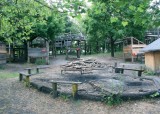 In Berlin, the strong emphasis on nature and play means there’s not a great deal of concern or effort expended on making spaces look tidy. Grass gets worn or grows long and most sites have nettles and brambles. A key theme is space to hide and a philosophy that children need to be away from active supervision for part of the day. Planting has been designed to create hidden paths, dens and cover and in some schools up to 70 percent of the children are out of view of a supervisor during break time. Supervisors don’t generally circulate and police – they locate themselves at fairly fixed points so that any vulnerable children can stay close, and if there’s any trouble, children know where to find an adult. Yet, back home, one Scottish primary school recently ripped out its only bushes because playground supervisors couldn’t see all the children.
In Berlin, the strong emphasis on nature and play means there’s not a great deal of concern or effort expended on making spaces look tidy. Grass gets worn or grows long and most sites have nettles and brambles. A key theme is space to hide and a philosophy that children need to be away from active supervision for part of the day. Planting has been designed to create hidden paths, dens and cover and in some schools up to 70 percent of the children are out of view of a supervisor during break time. Supervisors don’t generally circulate and police – they locate themselves at fairly fixed points so that any vulnerable children can stay close, and if there’s any trouble, children know where to find an adult. Yet, back home, one Scottish primary school recently ripped out its only bushes because playground supervisors couldn’t see all the children.
All school playgrounds have an element of water play, with groups of pupils working cooperatively to build dams, collect water and operate pumps. A common pattern is to have water feeding into channels which often have a mix of fixed and loose rocks to allow children to change the course of the water and construct small dams and pools. Some have slots for sluice gates to allow damming. Using rainwater for play is a common theme, with rainwater collected from the main surfaced area of the playground draining into pools. In Britain, how many playtimes are lost due to rain?
All playgrounds have been re-profiled to introduce slopes and dips, creating spaces that stimulate running around and running up and down and almost all schools have tunnels through a man-made hill. Some have boulder ‘cliffs’, creating opportunities to climb as well as jump. Often these slopes help to enclose a seating area.
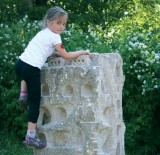 A very different attitude to risk is evident. Playgrounds are designed to create multiple opportunities for ‘good risks’ that can be clearly recognised and assessed. Children jump off six foot high rocks into sand or clamber onto roofs. Surfaces are sometimes designed to be uneven and there seems to be a general consensus in favour of risk. A large boulder pile with a climbing net was a new idea. The insurance company agreed to allow the school to build it and monitor any accidents. After a month of intensive play and no serious accidents, approval was given to keep the new feature. Teachers told us that the new natural playgrounds created a greater number of minor accidents than the old tarmac spaces – but that there were fewer serious accidents. Can you imagine witnessing that sort of play in your school?
A very different attitude to risk is evident. Playgrounds are designed to create multiple opportunities for ‘good risks’ that can be clearly recognised and assessed. Children jump off six foot high rocks into sand or clamber onto roofs. Surfaces are sometimes designed to be uneven and there seems to be a general consensus in favour of risk. A large boulder pile with a climbing net was a new idea. The insurance company agreed to allow the school to build it and monitor any accidents. After a month of intensive play and no serious accidents, approval was given to keep the new feature. Teachers told us that the new natural playgrounds created a greater number of minor accidents than the old tarmac spaces – but that there were fewer serious accidents. Can you imagine witnessing that sort of play in your school?
British playgrounds are often dominated by a few activities, generally football, tag and standing around. Our playgrounds are often dominated by formal sports facilities, most commonly football pitches, with play features being fitted in around the periphery. In Berlin, sports facilities are designed into a backdrop of natural play and there are more, smaller groups of children engaged in a much wider range of activities and making use of the whole outdoor space.
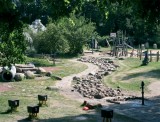 Berlin’s school playgrounds have been designed for play by experienced play designers, benefiting from a comprehensive planning and design process with extensive consultation with pupils and staff. This gives a very different result from the typical British school, where parents raise small sums of money and make small scale ad hoc improvements, often without having a co-ordinated plan. This isn’t surprising given that budgets for Berlin schools were typically 150K – 250k Euros – but it does highlight the gains that can be made from engaging a professional play designer.
Berlin’s school playgrounds have been designed for play by experienced play designers, benefiting from a comprehensive planning and design process with extensive consultation with pupils and staff. This gives a very different result from the typical British school, where parents raise small sums of money and make small scale ad hoc improvements, often without having a co-ordinated plan. This isn’t surprising given that budgets for Berlin schools were typically 150K – 250k Euros – but it does highlight the gains that can be made from engaging a professional play designer.
To implement such a radically different approach to adventurous play requires not only the physical transformation of the space, but also a shift in culture and attitudes. But undertaking wholescale, and sometimes expensive, changes to entire school sites is not the only way to reap the rewards that providing such experiences can bring. With the support of Grounds for Learning and funding from Inspiring Scotland, eight urban primary schools in Glasgow and North Lanarkshire have embraced the ‘Berlin approach’ and introduced a range of natural features for play.
Large-scale and structural improvements have included digging up tarmac, transforming flat areas with hillocks and dips, creating naturally playful surfaces with sand, bark and pebbles, or planting shrubby areas in which children can hide. Some schools have opted to introduce natural elements such as boulders and tree trunks for clambering on – and in one school a fantastic natural climbing frame has been created by sinking a huge dead tree into the grounds. More simply, in other schools pupils have been encouraged to discover the rich play value of smaller scale, loose, natural materials such as ash poles, tree trunk discs, logs, hazel sticks and straw bales. Others have also been experimenting with different kinds of mowing styles to create ‘child nests’ in areas of long grass.
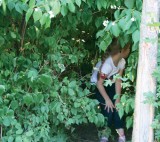 The benefits have been significant. There’s increased cooperation between children, greater interaction across year groups, increased levels of physical activity, better playtime behaviour and children settle more quickly in class. Providing these enriching experiences for children has challenged existing school culture, policy and practice. Playground supervisors are used to being able to see most of the children from one or two vantage points, and the prospect of children disappearing out of sight has raised all sorts of questions and anxieties. Schools have needed a lot of support with training and the development of play guidelines, management systems and risk benefit assessments. It’s not always been comfortable or easy, but teachers, supervisors and pupils alike all think it’s been worth it.
The benefits have been significant. There’s increased cooperation between children, greater interaction across year groups, increased levels of physical activity, better playtime behaviour and children settle more quickly in class. Providing these enriching experiences for children has challenged existing school culture, policy and practice. Playground supervisors are used to being able to see most of the children from one or two vantage points, and the prospect of children disappearing out of sight has raised all sorts of questions and anxieties. Schools have needed a lot of support with training and the development of play guidelines, management systems and risk benefit assessments. It’s not always been comfortable or easy, but teachers, supervisors and pupils alike all think it’s been worth it.
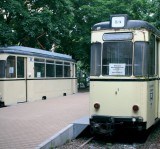 A change in culture and design at Thornlie Primary led to less conflict and more creativity…
A change in culture and design at Thornlie Primary led to less conflict and more creativity…
When headteacher David Hughes arrived at Thornlie Primary School in North Lanarkshire seven years ago, vandalism, graffiti and weekend drinking on the school premises happened regularly. “We had plenty of outside space, but there was a real failure to realise its potential. The local community felt little ownership of the facilities.” Hughes explains. The school involved pupils and other community members in a gradual process of making changes. Within weeks of being painted, some new playground markings were vandalised, but with the persistence and the commitment of pupils, other changes - such as murals to brighten the school buildings - began to be left untouched.
Funding from Inspiring Scotland’s Go Play programme enabled Thornlie to transform the outdoor play opportunities at the school. Balancing and jumping activities are enabled through the provision of boulders and timber structures in previously open area of grass; simple landscaping to include hillocks and dips allow children to run, climb and roll; and the provision of loose natural materials has seen children lifting sand, bark, logs and poles. The physical changes to the space required a similar shift in the culture, policy and practice of the school and its pupils, as well as the wider community. Thornlie used parents’ evenings and open days to introduce the development of new play policies and a risk benefit framework, highlighting the value of adventurous outdoor play and the role of risk and challenge in helping children be more physically active and confident. The school underpinned its new outdoor play culture by providing training for teachers and lunchtime supervisors in how to support active play effectively.
Thornlie recently received a glowing evaluation from HMIE. David Hughes, too, has seen promising improvements in children’s social interaction and creativity: “Children who come to us haven’t always been well guided in how to sort out conflict,” he says. “We have never had a year with no suspensions, and a number of these previously started in the playground. Teaching children to emotionally problem solve remains high on our agenda, but as we enter the summer term we have had zero exclusions this session.”
Views on the new playground from staff and children at Thornlie Primary…
The teachers
• “The kids are more settled. They are calmer, they are playing across the age ranges more – there’s more buddying, with older children helping younger children.”
• “They are definitely more active. There is a lot more running about rather than just standing on the concrete… it is a great team building thing.”
The supervisors
• “You see such a difference in the kids’ ehaviour. There is not so much fighting, there is not so much contact because they have got something to do.”
The pupils
• “See before it was just plain concrete and grass so it is much funner now you get to play more and do more things.”
• “When we had the normal playground all we could play was football.”
Alastair Seaman manages Grounds for Learning, LTL’s programme in Scotland. He is an experienced manager with a background in business and the charitable sector.
To find out more about this approach, visit the Learning through Landscapes website (ltl.org.uk) or their YouTube channel to see some short films of the play spaces in use. Visit their Facebook page to share your own views on how your grounds are used.
Supporting parents with maths
Ace-Maths
Top tips for differentiation
Ace-Maths
